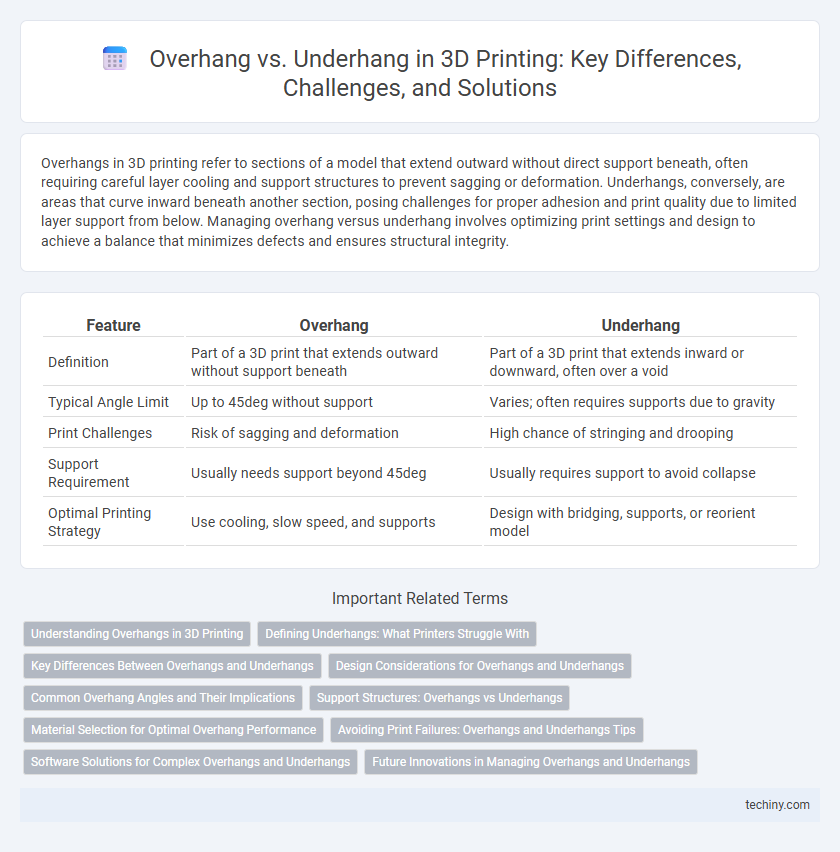Overhangs in 3D printing refer to sections of a model that extend outward without direct support beneath, often requiring careful layer cooling and support structures to prevent sagging or deformation. Underhangs, conversely, are areas that curve inward beneath another section, posing challenges for proper adhesion and print quality due to limited layer support from below. Managing overhang versus underhang involves optimizing print settings and design to achieve a balance that minimizes defects and ensures structural integrity.
Table of Comparison
| Feature | Overhang | Underhang |
|---|---|---|
| Definition | Part of a 3D print that extends outward without support beneath | Part of a 3D print that extends inward or downward, often over a void |
| Typical Angle Limit | Up to 45deg without support | Varies; often requires supports due to gravity |
| Print Challenges | Risk of sagging and deformation | High chance of stringing and drooping |
| Support Requirement | Usually needs support beyond 45deg | Usually requires support to avoid collapse |
| Optimal Printing Strategy | Use cooling, slow speed, and supports | Design with bridging, supports, or reorient model |
Understanding Overhangs in 3D Printing
Overhangs in 3D printing refer to sections of a model that extend outward without direct support from the layer below, challenging the printer's ability to deposit material accurately. Proper understanding of overhang angles, typically those exceeding 45 degrees, is crucial to prevent sagging or warping during the printing process. Techniques such as adding support structures or adjusting print orientation enhance overhang quality and ensure dimensional accuracy in final prints.
Defining Underhangs: What Printers Struggle With
Underhangs in 3D printing occur when a layer extends outward beneath a previous layer, creating a challenging unsupported area for printers. Unlike overhangs, which protrude outward and can be partially supported by preceding layers or structures, underhangs often lack adequate support, leading to sagging, stringing, or poor surface quality. Printers struggle with underhangs due to limited cooling control and insufficient bridging capabilities, making precise calibration of print speed and cooling essential for improved results.
Key Differences Between Overhangs and Underhangs
Overhangs in 3D printing refer to parts of a model that extend outward horizontally without support underneath, often requiring careful print settings or support structures to prevent sagging or deformation. Underhangs, by contrast, are sections that protrude downward, necessitating different support strategies due to gravity's effects on the print material. Understanding these distinctions is critical for optimizing layer adhesion, minimizing print defects, and achieving precise dimensional accuracy in complex geometries.
Design Considerations for Overhangs and Underhangs
Overhangs in 3D printing require careful angle design, typically not exceeding 45 degrees without support to prevent sagging or poor layer adhesion. Underhangs demand reinforced layering strategies and support structures to maintain dimensional accuracy and surface quality. Optimizing overhang and underhang geometries enhances print strength, reduces material waste, and minimizes post-processing efforts.
Common Overhang Angles and Their Implications
Common overhang angles in 3D printing typically range between 30 to 45 degrees, where most printers can handle without significant support structures. Angles exceeding 45 degrees often require additional supports to prevent sagging or warping, impacting print quality and post-processing time. Understanding these angles aids in optimizing print orientation and material usage for improved structural integrity and surface finish.
Support Structures: Overhangs vs Underhangs
Support structures play a crucial role in 3D printing when dealing with overhangs and underhangs, as overhangs require additional material to prevent sagging or collapse during the printing process. Overhangs exceeding 45 degrees typically need support, while underhangs, often found in internal cavities or inverted features, demand precise support placement to ensure structural integrity. Optimizing support structures reduces material waste and post-processing, improving print quality and efficiency.
Material Selection for Optimal Overhang Performance
Material selection is crucial for optimizing overhang performance in 3D printing, with flexible filaments like TPU and advanced PLA blends providing better layer adhesion and reduced sagging. High-temperature materials such as ABS and polycarbonate offer enhanced mechanical strength, allowing for longer unsupported overhangs without deformation. Choosing filaments with superior flow properties and thermal resistance directly improves print quality and minimizes the need for excessive support structures.
Avoiding Print Failures: Overhangs and Underhangs Tips
Overhangs and underhangs pose significant challenges in 3D printing due to the risk of sagging and poor layer adhesion, which can lead to print failures. To avoid these issues, optimize print orientation, use support structures, and adjust cooling settings to enhance layer stability. Employing proper slicer settings for overhang angles and ensuring a well-calibrated printer bed reduce deformation and improve overall print quality.
Software Solutions for Complex Overhangs and Underhangs
Advanced 3D printing software leverages sophisticated algorithms to optimize support structures for complex overhangs and underhangs, ensuring precise deposition and minimal material waste. Features like adaptive slicing and dynamic support generation enhance print accuracy by adjusting layer thickness and orientation based on geometric analysis. Integration of AI-driven modeling tools enables real-time simulation and correction, reducing print failures and improving surface quality on intricate parts.
Future Innovations in Managing Overhangs and Underhangs
Future innovations in managing overhangs and underhangs in 3D printing include advanced support structures using soluble and biodegradable materials, enabling cleaner removal and improved surface finish. Adaptive slicing techniques driven by AI optimize layer thickness and printing paths to enhance the stability and accuracy of complex geometries with challenging overhangs. Integration of real-time monitoring systems with feedback loops facilitates precise control over extrusion and cooling rates, reducing defects in areas prone to underhang issues.
Overhang vs Underhang Infographic

 techiny.com
techiny.com